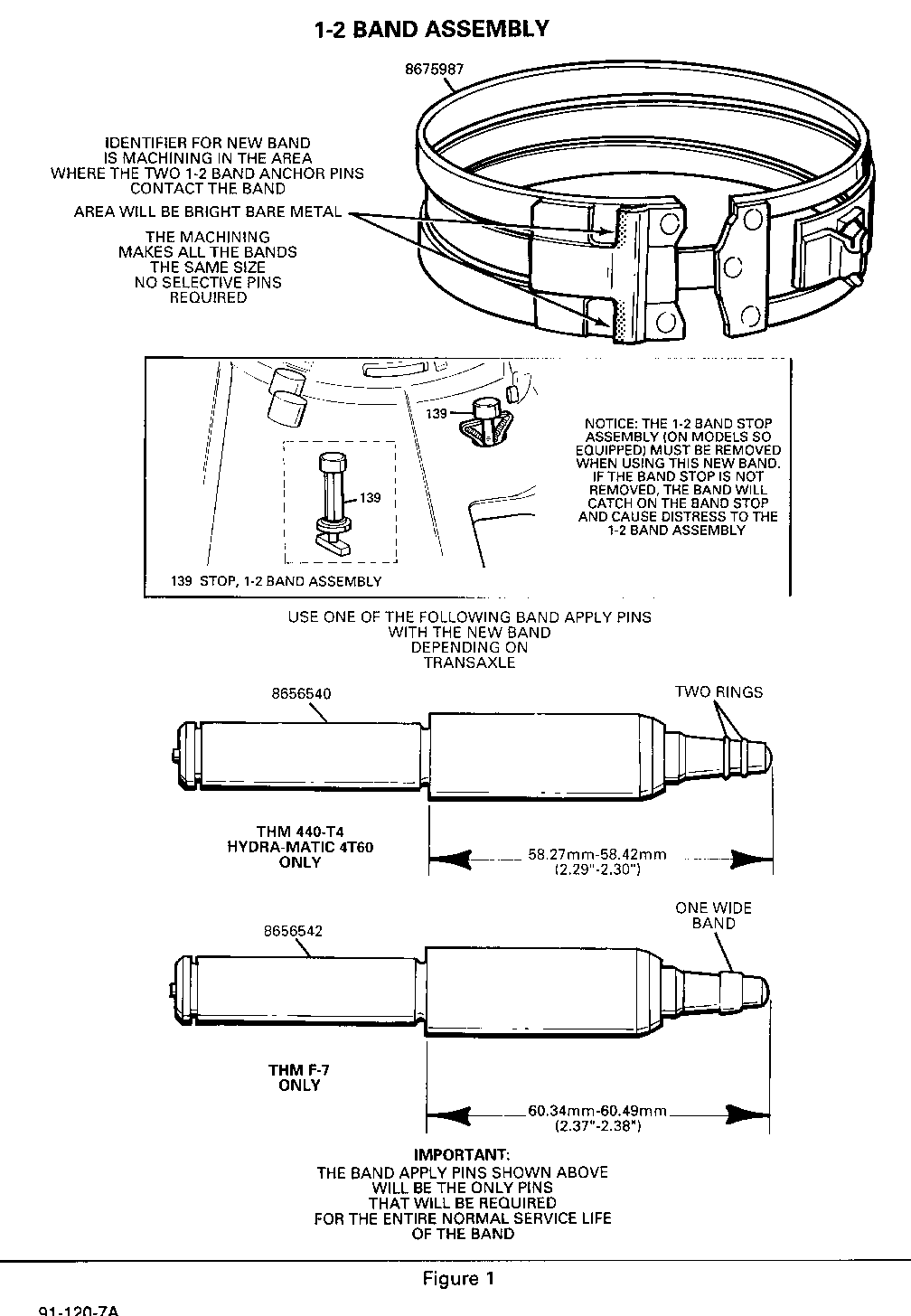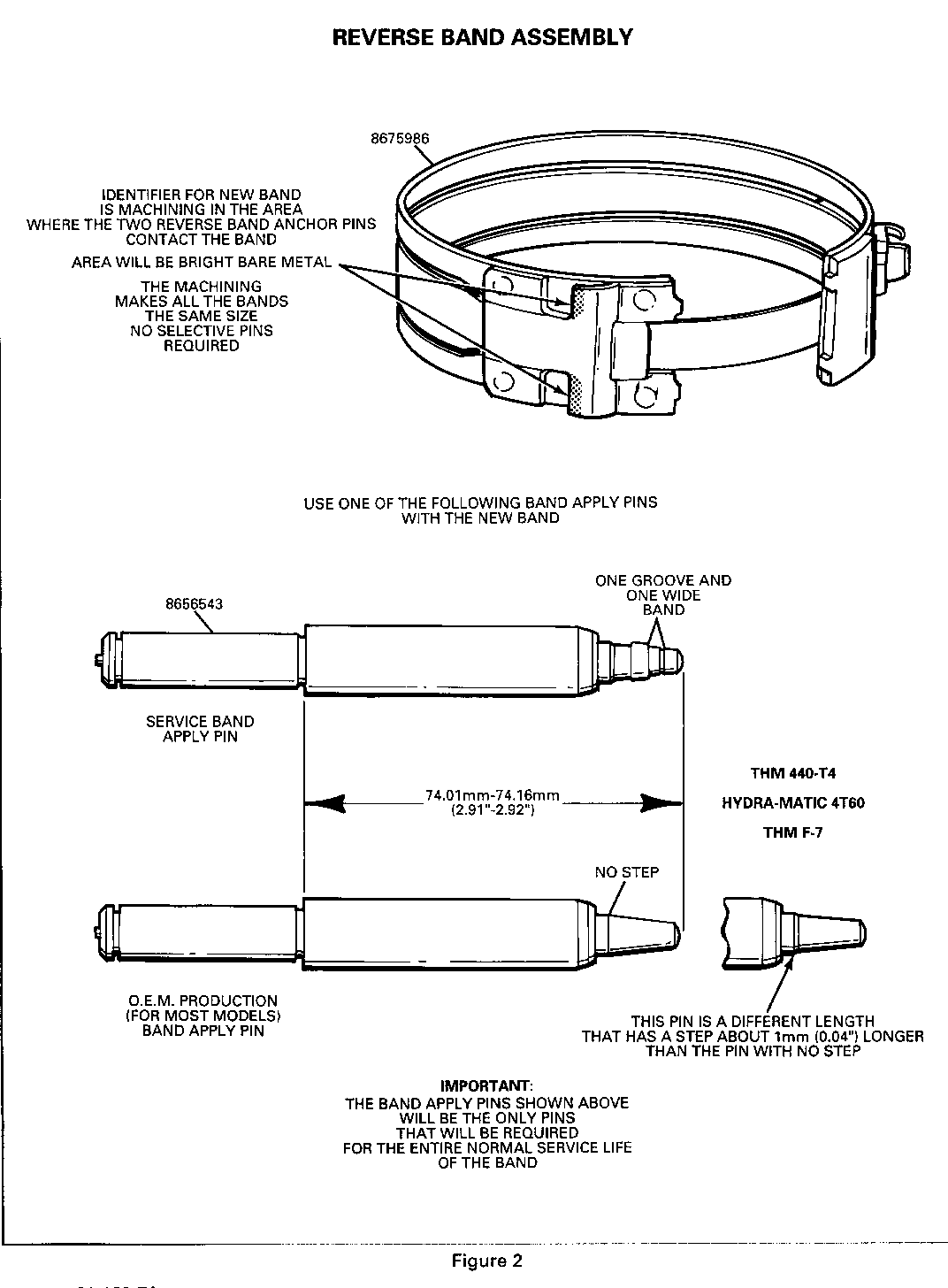NEW 1-2 AND REVERSE BANDS NO SELECTIVE BAND APPLY PINS

Subject: NEW 1-2 AND REVERSE BANDS - NO SELECTIVE BAND APPLY PINS REQUIRED
Model and Year: 1984-90 CELEBRITY AND 1990-91 LUMINA WITH 4T60 (44O-T4) AUTOMATIC TRANSMISSION
TO: ALL CHEVROLET DEALERS
THIS BULLETIN CANCELS AND SUPERCEDES DEALER SERVICE BULLETIN NO. 91-88-7A, DATED OCTOBER 1990. SERVICE PART NUMBERS HAVE BEEN CORRECTED AND AN EXCEPTION STATEMENT ADDED TO THE END OF THE SERVICE MANUAL REFERENCE. ALL COPIES OF 91-88-7A SHOULD BE DISCARDED.
BULLETIN COVERS: (Figures 1 and 2)
New 1-2 and reverse band assemblies that do not require selective band apply pins. A new manufacturing process machines the area where the case anchor pins contact the band. With this new process, all the 1-2 bands are the same size and all the reverse bands are the same size. With the bands all the same size, selective band apply pins are not required. Now, there is no need to measure for selective band apply pins for the entire normal service life of the band.
SERVICE PROCEDURE:
Do not measure for selective band apply pins - this will be removed from the labor time allowance for all applicable 1991 labor K-codes. If replacing a 1984 through 1991 model year transaxle 1-2 or reverse band, it is not necessary to measure for selective band apply pin(s), provided that the band service package contains an instruction sheet about the non-selective band apply pin band.
IMPORTANT: If ordering a new 1-2 or reverse band, the correct band apply pin must be used with the band. The correct band apply pin is not included with the new band service package(s) (that includes an instruction sheet about the non- selective band apply pin band). The proper band apply pin must be ordered separately.
NOTICE: If replacing a 1-2 band with the new 1-2 band listed in this bulletin, the 1-2 band stop (on models so equipped) must be removed prior to installing the band. The 1-2 band stop, if not removed, would cause the new 1-2 band to remain partly applied, distressing the 1-2 band. Reference Dealer Service Bulletin No. 99-197- 7A.
IMPORTANT:If replacing reverse band assembly, the new band also has the new friction material that will help decrease reverse engagement concerns. Reference Dealer Service Bulletin No. 90-243-7A.
DATE OF PRODUCTION CHANGE:
Beginning July 2, 1990 (Julian Date 183), all 1991 HYDRA-MATIC 4T60 transaxles were built with the new 1-2 and reverse band assemblies.
SERVICE PARTS INFORMATION:
The new bands will replace the previous bands.
Part Model Number Description Year Model Usage ------- -------------------------- ------- ------------ 8675986 Package - Reverse Band Asm. 1984-91 All - Reverse Band Assembly - Instruction Sheet
8656543 Pin - Reverse Band Apply 1984-91 All
8675987 Package - 1-2 Band Asm. 1984-91 All - 1-2 Band Assembly - Instruction Sheet
8656540 Pin - 1-2 Band Apply 1984-91 All
Parts are currently available from GMSPO.
SERVICE MANUAL REFERENCE:
Refer to the appropriate Service Manual for proper disassembly and assembly procedures. The 1991 Service Manual shows the procedure to measure the 1-2 and reverse band apply pins and should be disregarded.


General Motors bulletins are intended for use by professional technicians, not a "do-it-yourselfer". They are written to inform those technicians of conditions that may occur on some vehicles, or to provide information that could assist in the proper service of a vehicle. Properly trained technicians have the equipment, tools, safety instructions and know-how to do a job properly and safely. If a condition is described, do not assume that the bulletin applies to your vehicle, or that your vehicle will have that condition. See a General Motors dealer servicing your brand of General Motors vehicle for information on whether your vehicle may benefit from the information.
